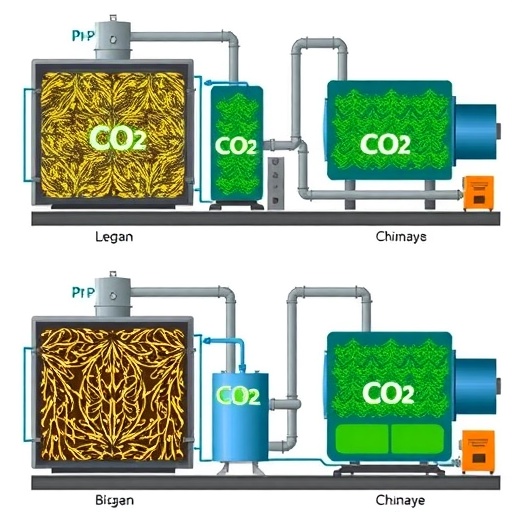In recent years, the pressing issue of sustainable energy has pushed researchers to explore more efficient methods of biomass gasification. Inocencio-García, Solarte-Toro, and Cardona Alzate have conducted pivotal research that contributes significantly to this field through a comprehensive experimental comparison of CO₂-assisted and conventional downdraft biomass gasification using corn cob and pine wood. Their study not only sheds light on different gasification techniques but also provides insights that could pave the way for more sustainable energy solutions.
Biomass gasification is a thermochemical process that converts organic materials into a synthesis gas, commonly referred to as syngas. This gas serves as a valuable intermediate for producing clean energy. However, traditional gasification methods often face challenges such as lower efficiency and higher emissions. The research team applied a novel approach, integrating CO₂ assistance, which has garnered attention for its potential to enhance the efficiency of the gasification process.
The researchers embarked on their investigation by establishing a robust experimental setup where both corn cob and pine wood were subjected to gasification under controlled conditions. They meticulously monitored critical parameters throughout the process, including temperature, biomass feedstock characteristics, and the flow rate of the oxidizing agents. These variables are vital, as they can significantly influence the yield and composition of the produced syngas.
A core focus of their research centered on the effect that the introduction of CO₂ had on the gasification process. By substituting some of the air typically used in conventional downdraft gasification with CO₂, the researchers aimed to create an environment that could potentially increase the production of hydrogen and methane. This modification posits an intriguing solution to enhance energy output while also mitigating some adverse emissions typically associated with biomass gasification.
The experimental findings revealed compelling differences between the two gasification methods. CO₂-assisted gasification led to a noticeable increase in syngas yield, achieving higher heating values compared to the conventional approach. This improvement signifies a leap towards making biomass gasification economically viable and more environmentally favorable, as the enhanced yield directly correlates with better energy production.
Moreover, the researchers discovered that the nature of the biomass fed into the gasification unit plays a critical role in determining the efficiency of the process. Corn cob, with its unique composition, demonstrated distinct behaviors during gasification compared to pine wood. The chemical and physical characteristics of the feedstock can dictate the interactions taking place at elevated temperatures. Thus, understanding these interactions is essential for optimizing gasification systems tailored to specific biomass types.
An intriguing aspect of the study was the environmental implications brought about by the CO₂-assisted method. In a world grappling with escalating greenhouse gas emissions, utilizing CO₂ in gasification could provide a win-win situation. This technique not only enhances energy outputs but could also help in utilizing CO₂ that would otherwise be released into the atmosphere. Thus, the innovative applications of this method offer a sustainable avenue for managing carbon emissions within the energy sector.
This research pushes the boundaries of traditional biomass gasification by advocating for an integrated approach that encompasses environmental sustainability alongside energy efficiency. The findings underscore the necessity for continued innovation in biomass technologies and emphasize the importance of such comparative studies. By expanding the horizons of our understanding in energy production, stakeholders in the field can better navigate the complexities associated with transitioning to greener energy systems.
The article’s authors emphasize the potential economic benefits alongside the environmental gains demonstrated in their study. Increased efficiency in biomass gasification translates to reduced operational costs and potentially more competitive standing in the renewable energy market. This poses an intriguing dilemma for policymakers and industry stakeholders: to consider investing further in research and development around these emerging technologies.
Moreover, the research could catalyze future investigations focused on scaling the CO₂-assisted gasification process. The experimental setup provides a foundational framework that can be adapted to larger systems, thus allowing for real-world applications in different geographical contexts. As legislators align efforts to combat climate change with sustainable development goals, studies like this could serve as crucial building blocks in crafting impactful policies.
In summary, the exploration initiated by Inocencio-García and colleagues paints a promising picture for the world of biomass gasification. Their innovative approach, fixed on improving efficiency and reducing environmental impact, opens diverse avenues for clean energy production. The implications of their findings may resonate beyond academia—potentially inspiring new approaches within industries reliant on energy production.
As the globe grapples with the chronic energy crisis while striving to mitigate climate change, the integration of advanced methodologies such as CO₂-assisted gasification showcases the path forward. This research holds the promise of capitalizing on the rich abundance of biomass—transforming waste into valuable energy resources while furthering the commitment to sustainable practices. The collaborative essence of this field of study exemplifies how collective knowledge and research can lead to transformative changes in how we harness and produce energy.
The insights gained from this research not only strengthen the scientific community’s understanding but also bolster practical applications across various sectors in need of renewable and sustainable energy solutions.
Subject of Research: Biomass Gasification
Article Title: Experimental comparison of CO2-assisted and conventional downdraft biomass gasification of corn cob and pine wood.
Article References: Inocencio-García, PJ., Solarte-Toro, J.C. & Cardona Alzate, C.A. Experimental comparison of CO2-assisted and conventional downdraft biomass gasification of corn cob and pine wood. Environ Sci Pollut Res (2025). https://doi.org/10.1007/s11356-025-36909-z
Image Credits: AI Generated
DOI: https://doi.org/10.1007/s11356-025-36909-z
Keywords: Biomass Gasification, CO₂-assistance, Energy Efficiency, Environmental Sustainability, Corn Cob, Pine Wood, Syngas, Clean Energy.




